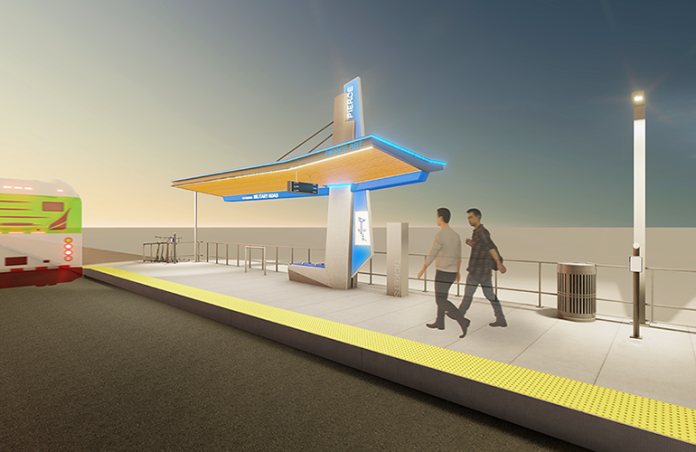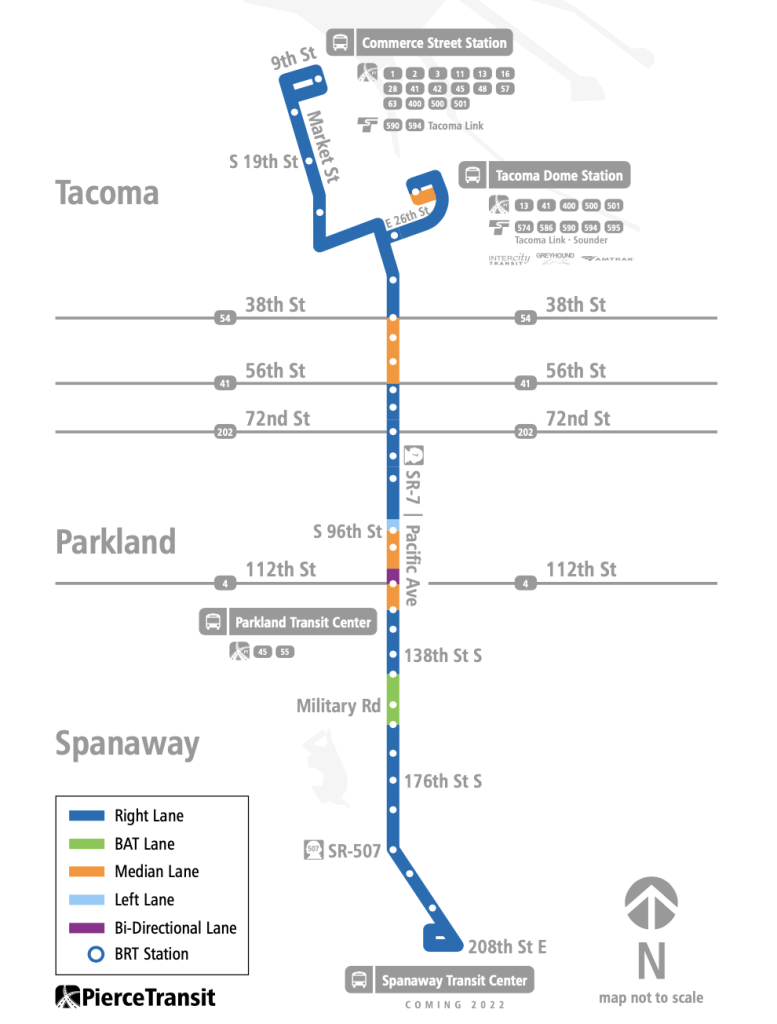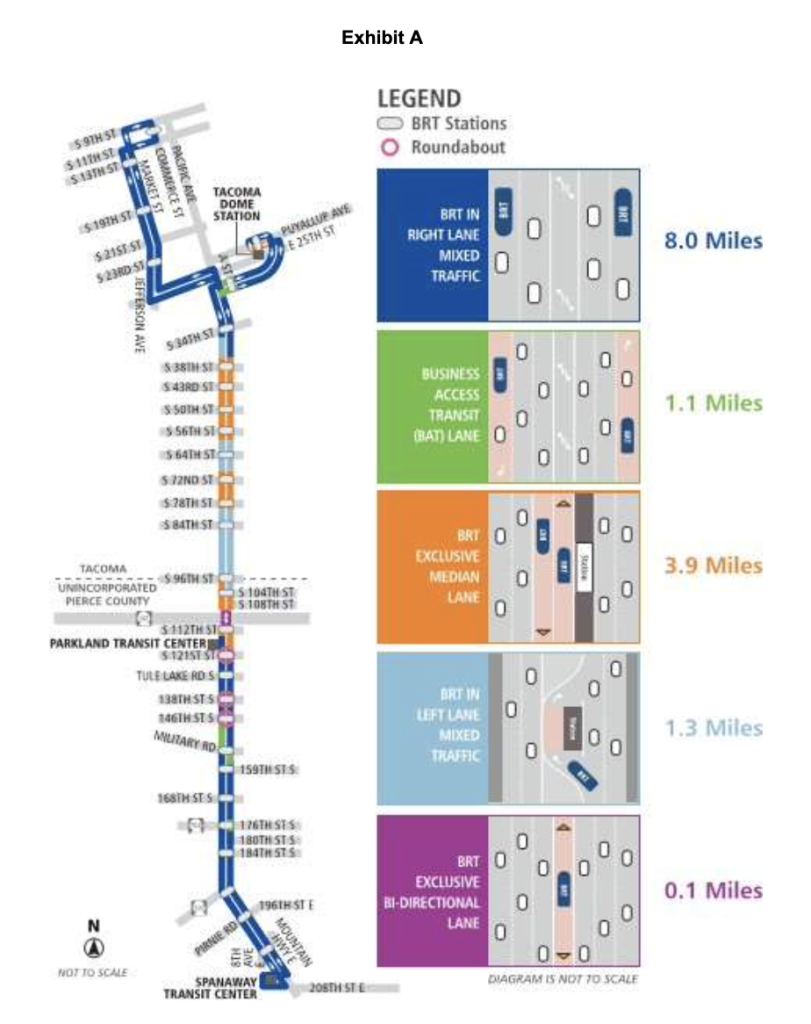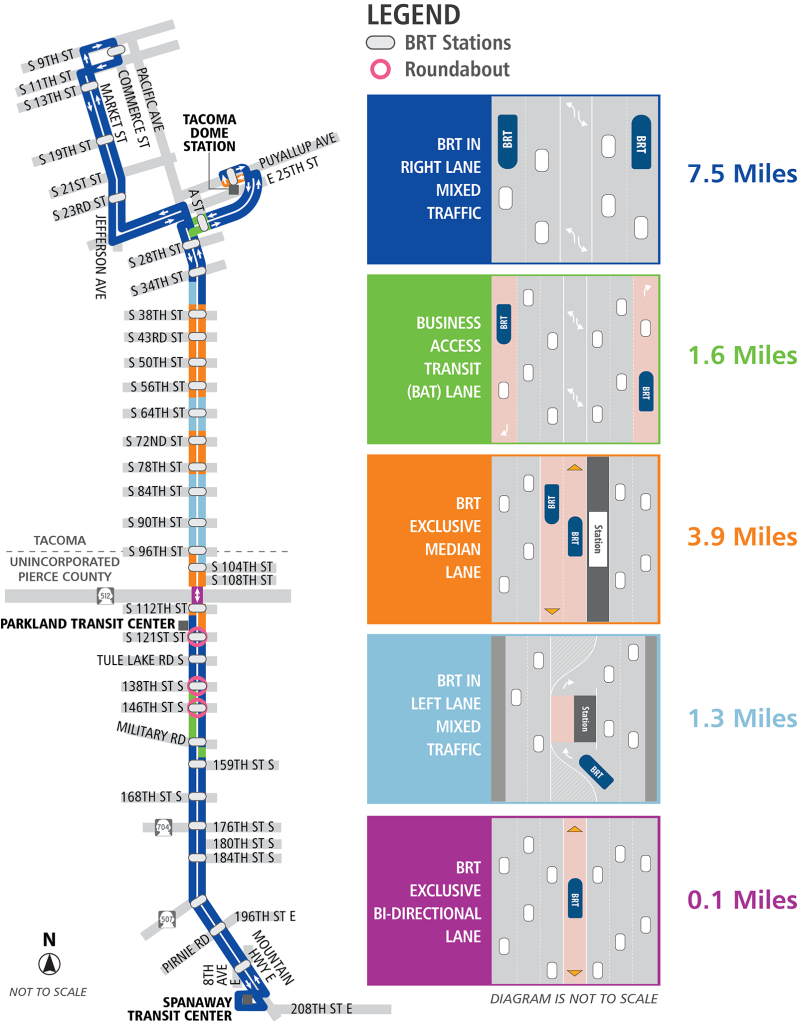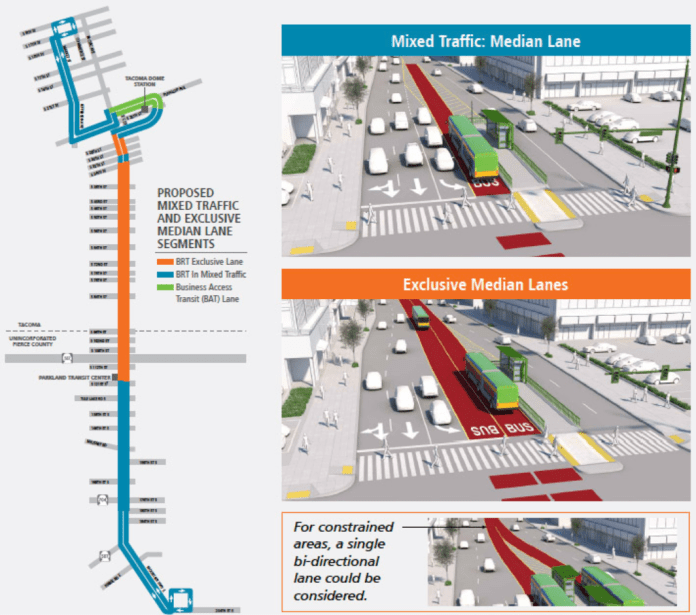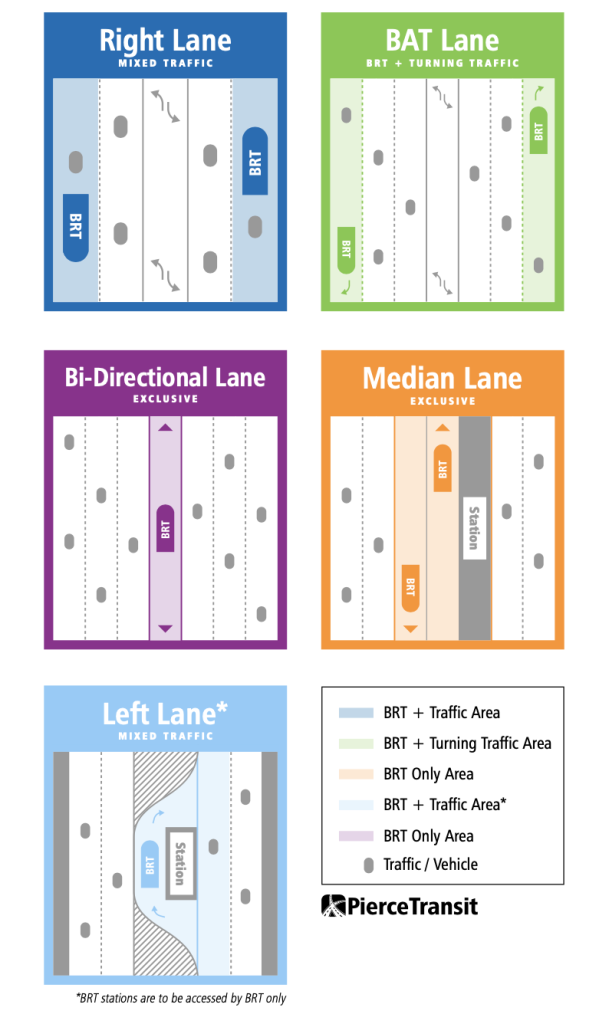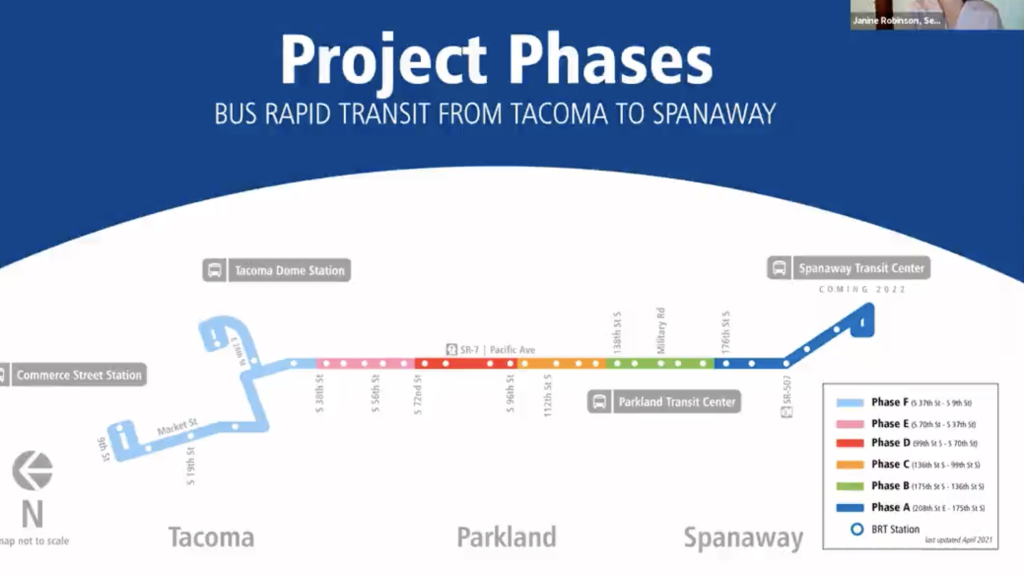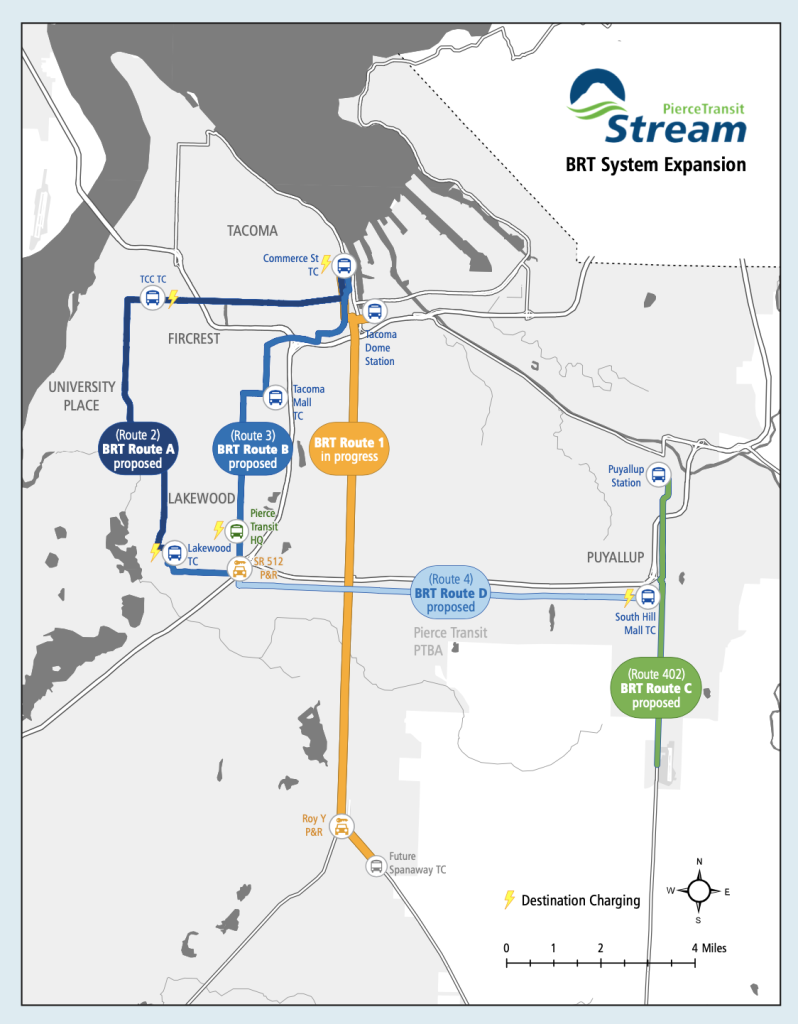Pierce Transit is advancing its new bus rapid transit (BRT) program, Stream, with a first line planned from Tacoma to Spanaway that the agency hopes will encourage further expansions. In June, the Pierce Transit board of commissioners approved a study that could bring four more Stream lines into service by 2040. But the initial line continues to stagger as the Pacific Avenue/SR-7 design advances. Cutbacks over the past two years have trimmed back exclusive right-of-way mileage. Those changes could reduce operational speeds and reliability on the corridor, but Pierce Transit thinks targeted investments will do the job.
Trimming back service quality of Stream’s first line
Fully separated, exclusive right-of-way is the gold standard of BRT, but at no point has Stream aimed to meet that. Instead, Pierce Transit has proposed exclusive median BRT lanes for segments of the corridor and supplemented the project with business access and transit (BAT) lanes in order to speed buses along congested portions of the corridor. Other unique strategies have also been proposed throughout the corridor along with transit signal priority tools at intersections.
In July, Pierce Transit quietly posted an updated map of the Pacific Avenue/SR-7 BRT corridor showing different types of lane treatments along it. Those treatments are a mixed bag with some downgrades and some upgrades from what previous maps showed, including one in an amended joint memorandum of understanding (MOU) approved in June. Throughout the design process, the quality of BRT lanes — whether exclusive or business access and transit (BAT) — has been repeatedly ratcheted downward to mixed traffic, but the latest version partially restores some exclusive median lanes, the agency says.
Here’s how exclusive and semi-exclusive lane mileage has lurched over time:
- 2019 – over 6 miles of median exclusive lanes and about 1 mile of BAT lanes;
- May 2020 – 3.9 miles of median exclusive lanes, 0.1 bidirectional exclusive lanes, and 1.6 of BAT lanes;
- June 2021 – 3.9 miles of median exclusive lanes, 0.1 bidirectional exclusive lanes, and 1.1 of BAT lanes; and
- July 2021 – 4.5 miles of median exclusive lanes, 0.1 bidirectional exclusive lanes, and 1.0 of BAT lanes.
In the latest map, exclusive median lanes have been dropped from S 72nd St to S 78th St in favor of mixed traffic right lane operations. The update also fully dropped mixed traffic left lane operations from S 34th St to S 96th St wherever it was planned. The degree to which left lane operations and stations is beneficial varies and would have been dependent upon the operational conditions, but left lane traffic often encounters less stoppage if there are center turn pockets. The loss of exclusive median lanes is decidedly a big step backward for riders. Mixed traffic operations always risk slowdowns and delays, so having as much exclusive right-of-way is preferable.
Yet, Pierce Transit says that the update actually adds more exclusive median lanes on balance, going from 3.9 miles in the MOU design to 4.5 miles in the latest. That increase doesn’t seem to be represented in the map though, but Pierce Transit staff told The Urbanist that “the [map] attachment to the MOU is based on earlier design, closer to 30% design, the BRT corridor is evolving as we are nearing 60% design,” meaning that there should be meaningful and positive differences between the July map and June MOU map. Staff also mentioned that the latest design includes an additional roundabout proposed for S 96th St, bringing the total to four roundabouts; the others are proposed at S 121st St, S 138th St, and S 146th St. More details should be coming in the next few weeks as the agency heads into a mid-September open house for further outreach on the “Locally Preferred Alternative” plan.
Aside from design, the agency is focused on the staging of right-of-way acquisition which will largely start from the south and then head northward similar to the planned construction phases. Approximately 360 pieces of property will need to be acquired for the project with most being small parcels costing $40,000 or less. Sometime in 2022, construction on the 14.4-mile BRT line is expected to start and continue through 2023; opening of the line is expected thereafter.
Stream BRT expansion study approved
Pierce Transit is also embarking on a study for four additional BRT corridors under the Stream brand. In June, the agency’s board of directors approved an $812,000 contract with a consultant (KPFF, Inc.) to evaluate the new corridors, which were suggested in last year’s long-range plan update. The four corridors essentially follow the paths of Routes 2, 3, 4, and 402. Eventually all four corridors would intersect, offering riders excellent frequent transit connection opportunities. The new BRT lines would also provide riders with good access to regional centers, other high capacity transit (e.g., light rail and commuter), and local transit services.
Generally speaking, the proposed BRT corridors follow major arterials and highways that are zoned or eventually will be zoned for higher density residential and mixed-use development.
The conceptual lines and corridors are as follows:
- BRT Route A running from Downtown Tacoma to Lakewood Transit Center via Tacoma Community College (TCC);
- BRT Route B running from Downtown Tacoma to Lakewood Transit Center via Tacoma Mall and the SR-512 Park-and-Ride;
- BRT Route C running from South Hill Transit Center to the SR-512 Park-and-Ride; and
- BRT Route D running from Puyallup Station to Pierce County Airport.
Agency staff, however, have noted that BRT Route A might be better suited as a “BRT lite” project because “current Route 2 has the on-street characteristics to be built as a much lower cost BRT option.” Another reason cited for this is that “the S. 19th Street section would need to be forward compatible with the future Tacoma Link Streetcar (westbound) extension to TCC, planned for completion in 2039.” Added to this all is that Pierce Transit believes that state grant opportunities may allow the agency to build this BRT route early. However, no funding has been directly allocated yet, though the state legislature had identified $10 million for it in a draft transportation funding proposal this year.
The study will be tasked with several deliverables, including:
- Proposed alignments and comparison of varying high capacity transit technologies to understand feasibility of BRT upgrades;
- Identification of possible BRT stations with ideal spacing for service faster speeds and existing bus stops that should be closed;
- Analysis of capital costs and lifecycle operation cost estimates as well as estimates of planning and design costs;
- Identification of which routes could viably use 60-foot articulated battery-electric or other zero-emissions buses;
- Development of criteria to determine BRT route construction prioritization that considers geographic equity, ridership potential, and socioeconomic factors; and
- Identification of safety and access improvements for riders at and near BRT stations and other first-mile/last-mile connections.
As noted before, a specific prioritization and timeline for BRT projects will be determined by the study, but a staff presentation in June suggested routes may be delivered sequentially by alphabetic letter. Conceptual dates for state of service in a project schedule suggest 2027 for BRT Route A, 2032 for BRT Route B, 2037 for BRT Route C, and 2041 for BRT Route D.
The study should run through the remainder of this year and much of the next, though results of it could be delivered in the fall of 2022. Agency staff expect the effort to reach a 5% design milestone at its conclusion, offering an early idea of project requirements and improvements. This will be an important stepping stone for projects to advance into preliminary engineering and design when appropriate, given the staged expansion program.
For now, getting the first BRT project done will be a critical piece in building up Pierce Transit’s bus network and setting the tone for future expansions — perhaps opening up the possibility of accelerating BRT rollout to meet resident need and the scale of the climate emergency. There will be plenty of lessons learned from that project, especially once service is launched. Hopefully the cutbacks on exclusive right-of-way don’t weigh too heavily on the service, but they may end up being a warning to future projects.
Stephen is a professional urban planner in Puget Sound with a passion for sustainable, livable, and diverse cities. He is especially interested in how policies, regulations, and programs can promote positive outcomes for communities. With stints in great cities like Bellingham and Cork, Stephen currently lives in Seattle. He primarily covers land use and transportation issues and has been with The Urbanist since 2014.

